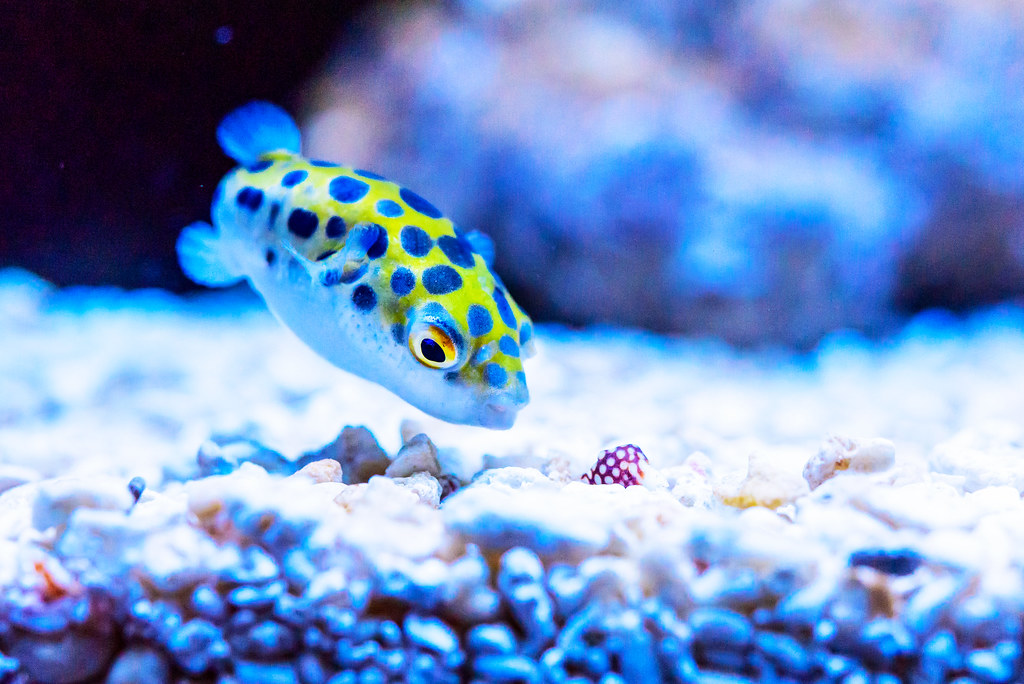Fish enthusiasts often ask Can spotted Congo Puffers be Alone without issues. This query is essential for someone considering keeping these specific fish in their aquarium. Spotted Congo Puffers, or Tetraodon schoutedeni, are petite freshwater puffers found mainly in the Congo River Basin.
With their looks and energetic nature, they are a favorite among aquarists. However, their social requirements and behavior can be unique compared to different fish species. Hence, knowing Can spotted Congo Puffers be Alone or with a companion is needed for their wellbeing.
This article will discuss Can spotted Congo Puffers be Alone, puffers’ social behavior, including territorial behavior, the implications of keeping them alone, and the social behavior of fish, focusing on spotted ones. It will also tackle ideal tank conditions, feeding habits, and possible tank mates.
Social Behavior that Spotted Congo Puffers Exhibit
Like many species of fish, spotted Congo puffers are known to be quite solitary. Unlike many species that benefit from a school of fish, these puffers have an independent streak.
They create territories in the wild to defend their food sources, which can cause problems when too many puffers are placed together. So, can spotted Congo Puffers be alone? The answer is yes. They can survive perfectly well in a solitary environment.
Aggression: Spotted Congo Puffers, like most puffer fish, are territorial and may show aggression towards other puffers, leading to violence. This behavior is heightened in smaller tanks, which are more restrictive. If two or more puffers are put in a small aquarium, they tend to fight for territory, which can lead to stress and injuries.
Self-sufficient: Every spotted Congo Puffer is unique; some may be liberal towards other fish, while others pursue an aggressive stance. This means that, with a single puffer, you tend to find a less aggressive fish and a less stressful environment for the fish.
Group Dynamics: If you decide to keep a few Spotted Congo Puffers, you must consider a larger aquarium. A few, at least six, can help disperse aggression, but it requires more close monitoring and more intricate tanks to reduce violence. Aggression can be curtailed in breeding behaviors if there are two females for every male population.
Ideal Tank measurements
These species are best kept alone in a breeding group to prevent aggression. Make it a point to create the ideal setting to bolster the wellbeing of your spotted Congo Puffers. Here are some important ones:
Tank Size: A minimum tank size of 40 gallons is recommended for a single-spotted Congo Puffer. For a group of six, a tank of at least 120 gallons is advisable so that these species can comfortably claim their spaces and not feel cramped. Each fish should be comfortable swimming and exploring without feeling chained.
Aquascaping: Use rock, plants, and driftwood to build an artificial reef that idolizes the natural environment surrounding them while adding an element of camouflage. This will aid the pufferfish in feeling less stressed while also providing them with places to hide. The plants and structures should be dense to lessen aggression so the fish can establish and claim their territories.
Water Quality: Spotted Congo Puffers are sensitive to water quality, which makes them fragile when it comes to cleanliness. Therefore, maintaining clean and well-filtered water is crucial for their health.
For ideal water conditions, some parameters include pH levels between 6.5 and 7.5 and temperatures between 75 and 79 °F. To maintain a healthy oxygen ratio in the environment, the tank’s water needs to be changed regularly.
These puffers favor moderate or low flow rates, which can be achieved by using spray bars on the tops of canister filters. A medium replenished water level encourages middle splashdowns from the filer, which helps with higher oxygen levels. To manage the waste these fish produce, a high degree of biological and mechanical filtration alongside high veins of oxygen is required.
Feeding Habits
Feeding is an essential aspect of fish care. Every type of fish has a different feeding pattern, so a varied diet is required to ensure their overall health and wellbeing.
In the wild, spotted Congo puffers feed on tiny crustaceans, worms, and snails, so it’s important to replicate the diet while in captivity. A proper diet should consist of over 50% snails and worms alongside fish and alternative high-quality pellets.
Consistent meals will support their wellbeing and stave off dental problems, as their teeth are growing and require some upkeep.
How often should they be fed?
Spotted Congo Puffers are best for small portions many times throughout the day instead of one large meal because this is closer to how they would naturally eat. This also prevents the tank from being overstuffed with food that was not consumed, contaminating the water.
World’s Apart Dental Care For Spotted Congo Puffers Stop ‘Dental Destruction’ Snacking on this food is vital for the dental health of the spotted Congo Puffers. Not offering these foods can have severe consequences that may require the intervention of a veterinarian. Breeding aquatic snails in a different system helps provide easier food access for your Puffer.
Is It Ok for Spotted Congo Puffers to Be Lonely?
To summarize, the short answer to the question, Can spotted Congo Puffers be Alone? is a hard yes. These fish are very independent animals and can do well as single pets with the right tank setup and care.
They can be social but do not look for social activities to live fulfilling lives. Having them alone is often healthier and more peaceful for them. If you wish to keep more than one fish, ensure your tank is of proper size and can accommodate their aggressive behavior towards each other.
To improve overall health and wellbeing, these fish should constantly be monitored to identify signs of stress or aggression. Furthermore, these fish tend to substantially outweigh their peers, so tanks that are more highly decorated with plenty of barriers should be provided to reduce arguments.
Conclusion: Can spotted Congo Puffers be Alone?
Spotted Congo Puffers are crazy-looking fish that can prove to be stunning pets for owners who take their care seriously. Although they are solitary pets at heart, they can flourish in groups, too, given the right tank conditions and their favorite foods. By ensuring a healthy atmosphere and balanced food, these wonderful fish can remain a company for many years.
FAQs: Can spotted Congo Puffers be Alone?
Can spotted Congo Puffers be alone?
Yes, the Spotted Congo Puffers can stay with other fast-moving fish; however, their predatory instincts might get triggered. Monitoring them to ensure no harm to them or the buffer is always advisable.
What Size Tank Is Appropriate For A Single Spotted Congo Puffer?
The Single-Spotted Congo Puffer can thrive really well in a 40-gallon tank. It is advisable to provide at least this much room for it.
How Frequently Should I Feed My Spotted Congo Puffer?
To keep your spotted Congo Puffer healthy, feed them various snails and other protein sources. Ideally, they should be given several small meals a day.
Do Spot Congo Puffers Have A Specific Water Temperature In Which They Thrive?
These fish do well in water temperatures ranging from 75 to 79 degrees Fahrenheit.
Should my spotted Congo Puffer Exhibit Aggressiveness? What Should My Next Steps Be?
In cases of aggression, it might be a good idea to either separate the fish to prevent injury or add more hiding spots for the fish within the tank.







